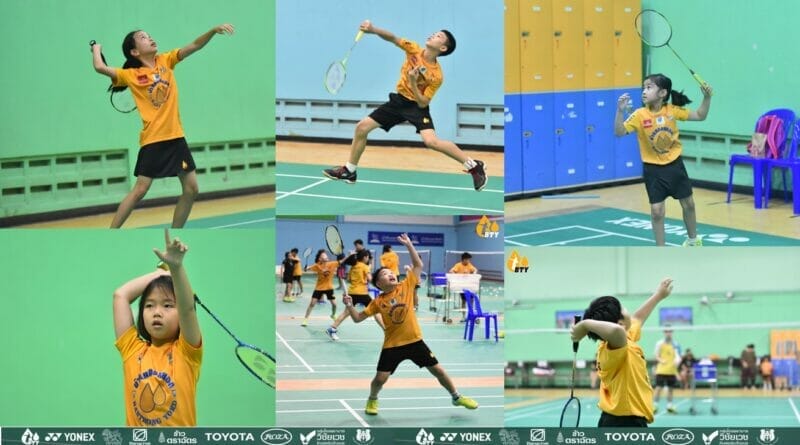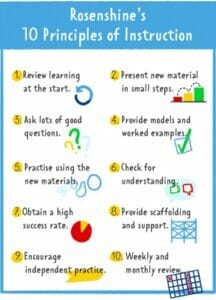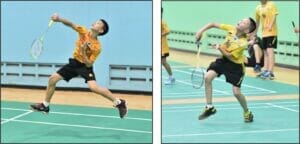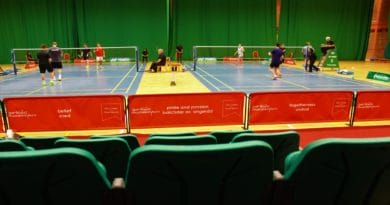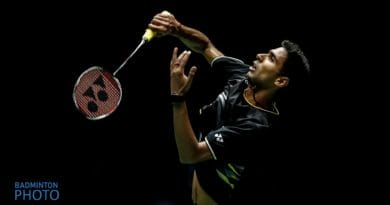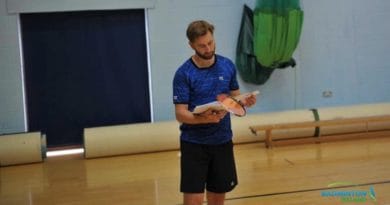Coaching the badminton overhead with beginners
What’s your plan for starting to develop forehand overheads
That was the question asked of me by an enthusiastic coach
They wanted something to follow step by step!
Is there a step-by-step guide?
There are certainly essential aspects to develop
But how could they be arranged in a structured practice?
I was contacted by a coaching friend

They had read this post all about those critical elements for all overhead striking.
They wanted to talk about the shortlist (only 4 points) that described the technical ‘must haves’ for badminton overheads.
Plus they felt that I needed to discuss how to plan for the development of the stroke, especially with young novice players. forehand. If you want to read it now click on this image.
It outlines those 4 technical aspects that I believe are the foundation for all overheads if power and efficiency (in all forms) are the goals.
The discussion
We both agreed that the tough aspect of planning was that you needed a plan, but you had to remain flexible. There was a potential conflict: plan but remain flexible in approach.
We started to write down all the aspects that we thought were important.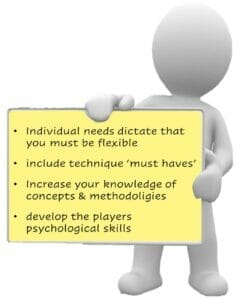
What should be included in any plan and what advice should coaches consider?
- There can never be a firm step-by-step plan to follow as each player has their individual needs. They develop at a different rate and occasionally a ‘mini-expert’ appears in front of you.
- However, you need a ‘plan’ and its must be flexible.
- The coach needs to have a large number of ideas, concepts, and methodologies that they know could work and be prepared to draw upon these.
- Any plan must include technical aspects that consistent and desirable throughout all overhead actions
- The coach must also develop the players’ psychological skills : acceptance of challenges, how to view errors, trust in the coach/process, and more.
I realised that this plan was going to be different than I expected
It would contain both general & specific aspects
It would help in creating sessions & probably be change during them
– – – – – – – – – – – – – – – –
How to use this information
There is not one method or plan or set of logical steps that guarantees a smooth path to develop a great badminton overhead forehand. The crucial aspect is the practice design by the coach. The why and how of what they do.
Coaches can (over time) acquire lots of information concerning the overhead forehand. There certainly isn’t a shortage of people stating the technical elements they believe need to be included, me included.
Deciding when to implement a particular practice or emphases certain aspects is critical. Often the timing is more important than what is done by the player.
This is the ‘hidden’ coaching skill.
Often the timing of the coach’s action is more important than the information presented
Appropriate moment + specific information = 🙂
– – – – – – – – – – – – – – – –
The ideas for you to select from
Here are 4 categories of information and ideas that should help you. Each is explained in more detail below, click on each bullet to read more.
It’s now up to you to consider what’s included in each and then to select what you feel is required from each. I’ve tried to give you some help under the ‘How to select’ heading.
 Consider all the categories, ideas, and specific points then decide what to select from each to form your plan.
Consider all the categories, ideas, and specific points then decide what to select from each to form your plan.
Click each one below to jump straight to the information
There is not a specific order of importance as all are important
- Develop ‘trust/confidence in the coach & the journey
- The early technique ‘must-haves
- Practice throwing and getting off the ground
- What could come before
- (How to select)
Please use ideas from each category and try not to spend too much time in the Technical area 🙂
– – – – – – – – – – – – – – – –
Develop trust/confidence in the coach & the journey
This is maybe the most important factor, although it can be difficult to create and hard to maintain. The badminton overhead is a complex, powerful movement with many variables that takes time to become an efficient movement program. Developing trust in the coach and the process is vital.
It’s in 2 parts
Part 1 : Players believe in the methods and advice of the coach. They see by their own development that there is value in ‘trusting the coach’. Plus any difficulties can be explored with the coach and eventually overcome. The coach’s advice works!
Part 2 : They believe that development is a journey with ‘bumps’, but it’s always progressing. They accept that the speed of development is not always the same and difficulties can be both easy or tough to overcome.
How to achieve this
- Create tasks and challenges just above or just below the players’ specific level (do both). Be aware that this will change from session to session. Progression is not always linear or forwards.
- Engage the players in the creation of the task/challenge, especially the difficult level. Ask players if it should be, normal, tough, or super-tough. Create practices that give varied rates of success: 80%, 60%, 40%
- Create ‘memorable moments’ of success in their minds. They must be able to recall these with no or limited promotion by the coach. They are memorable because the player believes that!
- Create an appreciation for how to react to errors and how they form part of the expected development journey.
- Structure/layer the practices and experiences, and decide what to do before something with the intention of part establishing the learning for the next practice challenge. Demonstrate through practice that ‘practice works!’
- Outline to the player how their own thoughts and vision define what could happen. When it does (using the above) reinforce that “they created the opportunity” themselves
- Plan in tough and easy’ish days then discuss with the players if the results were as expected
Engage players in their own practice, give them choices
Create these choices intentionally to both progress & challenge players
– – – – – – – – – – – – – – – –
The early technique ‘must haves’
These are those critical elements that you believe are essential for an efficient, robust badminton overhead.
 Those that all novice players should exhibit as part of any overhead forehands.
Those that all novice players should exhibit as part of any overhead forehands.
Ok, the novices may struggle to look like the ‘perfect model’ but neither will they include those classic overhead faults: pan-handle grip, pushing actions, no rotation, etc.
Click this link or the image to read the full post if you haven’t already
It’s vital to consider what elements will allow early success, but crucially not hinder future development and transfer of power. Plus these critical elements will still allow for multiple variations of effective techniques.
That is why they are called the ‘core must haves’ for a badminton overhead, NOT how to ‘achieve the perfect overhead!’
Your coaching challenge is how to introduce these to novice players
Try not to explain the reasons why they are vital, just encourage them!
My list
 “Get off the ground” – One or both feet will be off the ground when striking and in many cases, it will be both feet. This is not insisting on a vertical jump, but more so just being “off the ground” when striking.
“Get off the ground” – One or both feet will be off the ground when striking and in many cases, it will be both feet. This is not insisting on a vertical jump, but more so just being “off the ground” when striking.
“Prepare early” – Preparing early is essential. How early and the exact position is open for discussion. Be aware that the preparation position can vary from player to player and may change again as they develop and mature.
“Pull the elbow back” – Doing this will encourage a number of techniques/body positions and is essential for the preparation of power. How far and when the elbow is ‘pulled back’ is another discussion.
“Throw” – As a basic, all novice/beginner overheads should be performed with a throw. To do otherwise creates many issues that will hinder development. The size and speed of the throw are other important discussions.
Can you visualise what coaching situations, challenges, and practices would develop each?
– – – – – – – – – – – – – – – –
Practice throwing and getting off the ground
This was included in the “The early technique must haves” above, but for me, it deserves its own category
Throwing and rotation are essential to future development. However, they may ‘fight against a young player’s own self-discovery.
This is an important point for coaches to consider. If left alone to learn, how many novice players decide
– not to throw hard (rather they push at the shuttle)
– to stay on the ground (as jumping & rotating often cause complete miss hits)
Create many opportunities to throw and get off the court by
– Practice throwing the racket (but holding on to it!) rotating and listening for the ‘swish
– Throwing against a wall (preferably a ball rather than a shuttle)
– Jump/throw whilst standing over the side tramlines (try to land on the back leg and the lines)
– Observe and admire others with explosive but stylish overhead actions
– Hitting overhead targets – the basketball net, the coach’s fishing pole
Start by feeding into the RTH/BH court
 I wished I’d known the advantages of starting overhead coaching with the player in their Round The Head / Backhand court.
I wished I’d known the advantages of starting overhead coaching with the player in their Round The Head / Backhand court.
It would have saved me so much time and lessened the chance of inappropriate/limited techniques developing. It’s a simple choice and the differences between using either court really surprised me
I consciously make this decision every time now when introducing overhead hitting with a novice player
This post will explain why and give more advice
Coaches should be selecting and instilling these
2 aspects into all practices for novice players
– – – – – – – – – – – – – – – –
What could come before
Start with below shoulder strokes
There are many reasons for this, some are outlined below. I’ll go into more detail in another post.
It’s your decision to choose what to focus on and for how long in each session. I can only offer my thoughts based on my experience and of watching others succeed whilst others struggled.

Why not consider incorporating all these before starting on specific badminton overhead forehand strokes during the first 6 – 12 months for players aged from 6-10 years old.
- Bouncing shuttles – it’s much more than just bouncing a shuttle (click to read)
- Wallwork – Use practices to prevent the classic grips and hitting problems of Pan-handle and Finger Up the shaft (click to read)
- Develop effective badminton grips – lots of leads and practices for you to try (click to read)
- Start with the deep forehand – its so important and a great stroke to experience (click to read)
Players will of course hit some overheads,
but these will be not the main theme of any coaching
(why not try this for 6 months!)
– – – – – – – – – – – – – – – –
How to select
Your task is to consider the 4 categories above and to select what practices, and methodologies you want to use. Pick from each and create an effective session.
Consider the reasons WHY you make your selection, that is the most important aspect of your planning.
Could you base your selection on –
- The needs of the player(s) in front of you. The specific needs at that time.
- Do you need to build more player confidence in the coach (you) and the practice process?
- Helping players practice something without ‘knowing’ that they are practicing (think about this 🙂
- Do you feel it’s time to review a previously learned (?) skill or push toward something new
- Adding new material as part of a more complex movement
- Your desire to check previous learning/understanding without talking about it
Your role as a coach for novice players is to
Create an environment where learning, development, error prevention and smiles 🙂
all happen within a thought-out progressive plan
However, designing this plan may be your biggest coaching challenge, ask yourself
Am I doing things right?
Am I doing the right things?
How do I decide what is right?
– – – – – – – – – – – – – – – –
As always, I’m very grateful if you have read this far 🙂
If you have thought about developing the badminton overhead when working with novice players, I’d love to hear them.
If they differ from those above that’s ok, let’s start a conversation by sharing your thoughts, why not send me an email contact@badmintonandy.com

